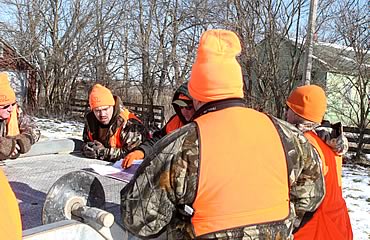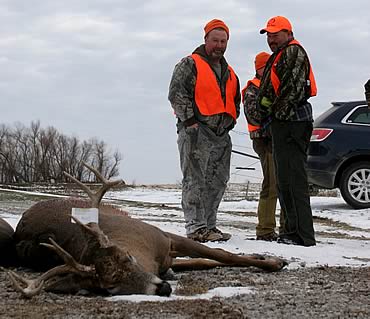Less can be more when it comes to pushing deer.
The morning hunt was uneventful, but as Mike Mattly and two friends watched a dandy buck slip into a small patch of cover, he knew things were about to get interesting. The three Iowa hunters were driving back to town when they spotted the buck on property they had permission to hunt, so after a few minutes of deliberation, they knew exactly what to do.
“It was the perfect situation for a drive. I got on one end of the patch of cover, and another guy got on the other while the third agreed to push the buck out of its bedding area,” he recalls.
Everything went as planned. After slipping into position, the walker quietly approached the small block of woods and moved the buck out of its bed. The 150-class whitetail trotted past Mattly, who dropped it with a single shot from his muzzleloader. He credits that buck to his experience with small-group drives, one of his favorite ways to hunt deer.
Instead of rounding up a dozen guns, Mattly, a lifelong Iowa resident, instead prefers to make drives with just a couple of friends. For him, two or three other hunters are just right. Sometimes, he’ll make small drives with just one other hunter.
 “Large groups present a bunch of considerations. Not only can organizing a dozen or more hunters turn into a logistical nightmare, it can take a whole lot more time. A big group also makes a lot more noise, and sometimes it’s tough to find a place to put everyone.
“Large groups present a bunch of considerations. Not only can organizing a dozen or more hunters turn into a logistical nightmare, it can take a whole lot more time. A big group also makes a lot more noise, and sometimes it’s tough to find a place to put everyone.
“I like to make a drive and then move to another spot without having to get everyone together and trying to figure out who’s going to stand where. With two or three other hunters, we can get in position, make a drive and then move on to the next one.”
Why drive? It goes against conventional wisdom to roust deer from their bedding areas and chase them out of the area, but in many places, that’s the only way to see deer during legal shooting hours. Once they’ve been hunted for a few days, whitetails turn into ghosts, vanishing until the cover of darkness.
Not only are drives a great way to see deer, they are also just plain fun. When other hunters are sitting in a diner waiting for the evening hunt, Mattly and his friends are kicking the brush and slipping through woodlots as they attempt to drive deer to each other. It doesn’t always work, but it often does.
“We see so many deer, and every year we take some pretty good bucks,” he said. “Believe it or not, we actually kill more big bucks by making drives than by stand-hunting.”
PRIME COUNTRY
The terrain and habitat of southern Iowa farm country is perfect for small-group drives. Five- and 10-acre woodlots and brushy creek bottoms and draws are scattered among vast crop fields and gently rolling pastures. Although bucks can hide in some pretty unusual places, they tend to favor the thicker cover of those woods and creek bottoms. And because those patches of timber are relatively small, it can be downright easy to surround them with just three or four hunters.
Some regions of whitetail country don’t lend themselves to small-group drives. The big woods of the North, the huge pine plantations of the South and rolling, wooded mountains of the mid-Atlantic and New England are simply too vast for a few guys to effectively drive. Even large groups have a hard time surrounding bedded deer in the big woods.
 That’s not to say it can’t be done, but the best country for pushing deer has small, broken tracts of cover surrounded by agriculture fields and other open areas. Everything from wooded creek or river bottoms, blocks of hardwoods, brushy fence lines and other clumps of good cover allow hunters to target specific bedding areas and keep an eye on known escape routes.
That’s not to say it can’t be done, but the best country for pushing deer has small, broken tracts of cover surrounded by agriculture fields and other open areas. Everything from wooded creek or river bottoms, blocks of hardwoods, brushy fence lines and other clumps of good cover allow hunters to target specific bedding areas and keep an eye on known escape routes.
If the land is hilly, that’s even better because it allows both drivers and blockers the freedom to get into position without walking in view of the cover. That’s important, says Mattly.
“You want to get set up without being seen. Large groups can surround a block of woods, but if a deer sees a hunter move into position, it’s either going to get up and go before the drive starts, or it will go around that stander,” Mattly said.
WALK SOFTLY
An organized drive with just a couple of hunters should be more like a group still-hunt than a raucous attempt to run deer out of the county. Mattly says the walkers have a good chance at a deer if they go about it right.
Instead of plowing head-first into the woods and creating lots of racket, he and his friends prefer to still-hunt as they try to jump deer.
“I’ve killed a bunch as I was making a drive, so I always take my time and look for bedded deer as I ease through the cover,” he said. “I don’t yell or crash through the woods like some guys do when making drives with a bunch of people. I go slow, stop for a little bit and look for a bedded deer or one that might be trying to sneak around behind me.”
Although he typically walks with the wind in his face — and the wind at the standers’ backs — Mattly knows other hunters who make drives with the wind at their backs. Instead of coming into visual contact with bedded deer, they let their scent move the deer to waiting hunters.
In many cases, whitetails don’t bolt at the scent of a human. Instead, they sneak away through the cover and often end up giving the blockers an easy shot.
“I like to push into the wind because the bigger bucks will almost always turn into the wind when they’ve been jumped,” Mattly said. “The younger deer and the does often just run in a straight line and go to the blockers, but the bigger bucks know better.”
Sometimes, bedded deer will stand up and pause as they try to figure out exactly what’s walking through their bedrooms. That’s why it’s important to be ready at all times. Mattly carries his muzzleloader in his hands, not over his shoulder, in case he gets such an opportunity.
STANDERS STAND STILL
Posting blockers in the right places is as important as pushing the woods effectively. Mattly says most novices want to hug thick cover because they assume that’s where the deer will go when they are pushed. Nothing could be farther from the truth. Where Mattly lives, the older deer, including the biggest bucks, tend to break out across open fields and run along exposed ridges. He said those older deer like the open country because they can see longer distances — and they’ve been shot at in thick cover. Mattly won’t hesitate to post a stander on an open ridge, but that stander has to sit perfectly still. Nothing will spook a running deer faster than a fidget ing hunter.
If standers can’t find a good place to wait without moving too close to the cover, Mattly likes to post them on another woodlot or creek bottom up to a quarter-mile away from the cover they are pushing. Jumped deer might run across open cover at first, but they’ll eventually dive into another thicket.
PATTERN THE DEER
Mattly knows exactly where to put standers based on years of experience. Whitetails, even those with a hunter pushing them, choose the same routes time after time. Mattly and a friend pushed a big buck out of a brushy creek bottom one day last season. The blocker missed, but a week later, they made the same drive and jumped the same buck. A second hunter also missed. Mattly figures if the buck survived the winter, it’ll be bedded in the same cover this year.
“They can be pretty predictable in their bedding areas and their escape routes, so with a little experience, you’ll know exactly where to put blockers,” he said. “Don’t drive the same areas more than once every four or five days or the deer will be able to predict you. If you put too much pressure on them, they’ll just leave.”
Read Recent Articles: • Make Your Scouting Count: Not all deer season preparation is created equal.
• The $5 Ground Blind: Sometimes you can’t beat what nature provides.
• All About Luck: Success isn’t always measured by animals on the ground.
This article was published in the September 2009 edition of Buckmasters Whitetail Magazine. Subscribe today to have Buckmasters delivered to your home.